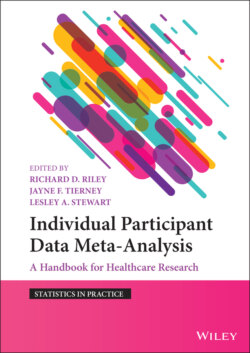Читать книгу Individual Participant Data Meta-Analysis - Группа авторов - Страница 70
4.2.1 Defining the Objectives and Eligibility Criteria
ОглавлениеUsually, the objectives and eligibility criteria for trials (and thus their IPD) will have already been defined, either in full or in part, using the PICOS or another similar framework,42 when developing a project scope (Section 3.3) or funding application (Section 3.9). However, they may still need to be refined at this stage. Figure 4.2 shows the PICOS elements that underlie the objective and eligibility criteria for an IPD meta‐analysis of pre‐operative chemotherapy for non‐small‐cell lung cancer.88
The type of trials deemed eligible for an IPD meta‐analysis project may depend not only on the specifics of the research question and the healthcare area, but also the proportion that are required for reliable synthesis, and are feasible to collect. Such elements should be explicitly considered in formulating the research question, and be built into the inclusion and exclusion criteria, with the rationale for doing so described. In healthcare areas where trials tend to be very large, it may not be worth including IPD from small trials if they would contribute little weight to the evidence base, but take a similar effort to obtain and manage as the larger trials. For example, in an IPD meta‐analysis of the efficacy and safety of more intensive lowering of LDL cholesterol, eligibility was restricted to those randomised trials that aimed to recruit 1,000 or more participants with a treatment duration of at least two years.89 However, depending on the research question, it should be noted that the information size for a trial usually depends on more factors than the total participants (Section 2.6.3), and that statistical power calculations can be used in advance of IPD collection to more appropriately identify which trials provide the most information (Chapter 12), and thereby indicate which should be prioritised for data collection.
Similarly, if older trials are potentially eligible, but might be particularly difficult to track down or are less applicable, then it might be appropriate to exclude them. For example, older trials using long‐term alkylating agents were excluded from an IPD meta‐analysis of the effects of adjuvant chemotherapy for non‐small‐cell lung cancer,90 because previously they had been found to be harmful to patients,12 and therefore were no longer of relevance to the clinical question.
The central research team might also prioritise seeking IPD from the trials deemed to be of higher quality, based on a formal risk of bias assessment,91 in order to focus their efforts on trials that would provide the most reliable IPD meta‐analysis results (Chapter 9). At the project design stage, necessarily, these judgements would have to be based on information obtained from trial protocols, publications, reports or trial investigators, rather than the IPD itself (Section 4.6).
